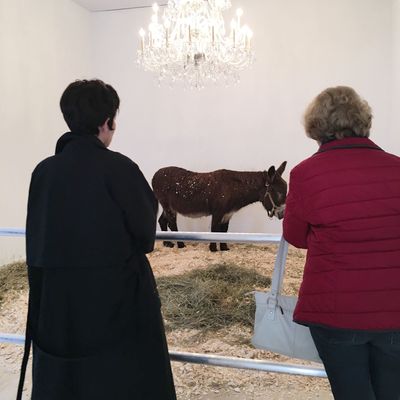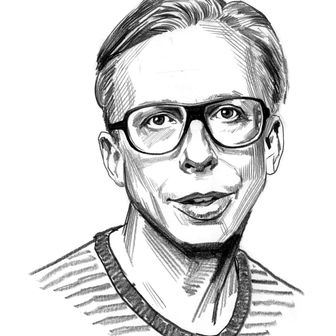
Earlier this week, I was standing in line to see a raggedy donkey loiter under a glittering chandelier in a tent. It was the Frieze art fair VIP day, Wednesday, and a woman behind me — smartly dressed and middle-aged, was patiently explicating this exalted 4-H scene to her apparently more middlebrow friend: “Do you know him? He’s out of the box. He makes fun of everything.”
“It’s a donkey?” her friend asked, as they were allowed inside the donkey annex, which featured straw on the floor.
“See, I told you we had to see it.”
She was not speaking of (or to) the animal, but about the artist, Maurizio Cattelan, who’d created this installation, which, as the wall text they were reading while in line explained, was a reenactment of his first first gallery show in New York, in 1994, at the Daniel Newburg Gallery, in Soho. Titled “Enter at Your Own Risk—Do Not Touch, Do Not Feed, No Smoking, No Photographs, No Dogs, Thank you,” it lasted less than a day — there were noise complaints, among other health hazards (at Frieze, the donkey is periodically allowed a break to go outside, though his handler, who called himself the donkey’s agent, told me the animal preferred to crap inside the tent, always in the same spot, stage left) — and it was also the final show of the Newburg Gallery, which was closing. The week before, the Frieze Projects curator, Cecilia Alemani, explained that in it, Cattelan, who was always inspired in his work by the specter of failure, “literally made an ass out of himself.” It was a form of self-portrait, co-opting you into the in-joke, which isn’t to say that it’s not profound, at least if you’re susceptible to such droll profundities (as I am). Alemani had told me that they were under some pressure to get the right donkey, which is to say one who wasn’t too cute, or the piece would lose its dolorous impact.
That donkey in a gallery marked the start of the most productive part of Cattelan’s rather heady art career, which made use of taxidermied animals and semi-allegorical wax figures, and somehow made him one of the most famous and successful artists of the ‘00s. It all literally culminated in a retrospective at the Guggenheim in 2011, titled “All,” in which he hung everything he ever made from trusses from the ceiling, dangling into the atrium bowl. At which point he declared he was retiring. “You ever feel tired and want to change occupations?” he asked me that year. “People have been asking for things for so long. If I was really making more works, I would have already. I don’t know … If you were in a band, you might feel you start to repeat yourself.”
But the market didn’t forget him: His 2001 work, “Him,” a boy-size Hitler apparently praying, is expected to sell at a Christie’s auction this month for between $10 million and $15 million; that would surpass “Untitled,” a 2001 wax self-portrait — complete with real hair — of Cattelan sticking his head out of a hole in the floor, which went for $7.9 million in 2010.
And so now, not unlike the Spice Girls (or LCD Soundsystem), he’s back for more, with the Frieze career-nativity scene, as well as a documentary, called, appropriately if coincidentally, Maurizio Cattelan: Be Right Back. It was named after a show he did back home in Italy, before he moved to New York, for which he produced no work, but merely placed a sign in the window of a gallery’s locked door, saying “Be Right Back” (in Italian, since it was in Italy). The doc premiered April 24, on the last day of the Tribeca Film Festival, in the Flash Gordon–groovy theater buried, crypt-like, under the Guggenheim drum, and was introduced by Nancy Spector, who’d curated “All.” The film, by Maura Axelrod, is deftly and entertainingly constructed, albeit under several rather daunting conceptual restraints, not the least being that Cattelan prefers not to talk on camera, or in public at all if he can help it, which is why, years back, he deputized the ridiculously articulate journalist turned curator Massimiliano Gioni to talk for him. Cattelan is, among other things, a charming and disarming master of collaboration, co-optation and manipulation, and, in order to get the documentary done, Axelrod experienced all those things from her subject. With a seductively raised eyebrow, he can make you want to be a part of the joke, too, and even feel protective of him. At the premiere, Axelrod admitted: ”We play with truth and fiction quite a lot in the film” (wait, is that actually his daughter in the film, who looks just like him and is called his archivist?). It tells a slightly mythologized version of his coming-of-age story — the portrait of an artist as a prankster — from Italian outsider-striver to, well, the Guggenheim. The moral of her tale seems to be, as Milanese gallerist Massimo De Carlo says in the film, “He has not dedicated himself to art, he has dedicated his life to success in art, which is different.”
Axelrod’s documentary started with the assumption that “I don’t think the general public knows who Maurizio Cattelan is,” she told me later. “I had to make the movie with all the different audiences in mind.” She’d met Cattelan when she was doing a TV-news segment on his infamous sculpture of the then-pope, John Paul II, struck by a meteorite, called “The Ninth Hour.” “I got really used to his work,” she says, about this attempt to bring it to a non-museumgoing audience, while also maintaining its credibility to those more familiar with him. “But it’s really quite shocking to the general public.” It’s part of Cattelan’s catalytic power. His work can provoke titters in the determinedly sophisticated, or provoke others to action: Some members of the Polish parliament, for example, tried to save this effigy of Pope John Paul II from its apparent humiliation.
The documentary also explores how, as Axelrod puts it, the “weird and nonsensical” art market works, and there are interesting and telling depictions of well-known collectors, from an ADD-afflicted Adam Lindemann to Alberto Mugrabi (depicted in ankle socks) to a dignified Dakis Joannou. Much of the film shows how Cattelan gets people who can help him to do so — curators, journalists, collectors, dealers, and, in the end, Axelrod herself. “His emotional radar is a pretty finely calibrated thing. He reads people and understands how they work,” says Axelrod. “It’s almost like you’re in on a joke, you’re a part of something.”
At certain points, she resorts to amusing animated segments to help move the story along.
The interviews with his sister and his ex-girlfriend are affecting, but it’s hard to break through to who Cattelan actually is — whatever that means exactly — which frustrated Axelrod, an experienced and accomplished journalist. “I worked in TV,” she says. “You’re trying to get people to cry. That’s the end goal on TV.” Part of her skill in that world was, she says, that “I was this empathetic woman.” But with this project, “I would try to get any sort of emotion,” out of the interviews, “and there was none. That was hard for me to accept.” Harder was that Cattelan, who helped with the documentary, wouldn’t be interviewed. “I thought I would be so awesome that I would get him to,” she says. “It took a while for me to realize that there was no way that that would happen. I was crushed.”
And so, as he has in the past, Massimiliano Gioni (who happens to be married to Alemani, and is today the artistic director of the New Museum) ventriloquizes a bit on camera for Cattelan. Though, at the premiere — which is also the first time he’d seen the doc — he seemed taken aback by how much he is a part of the film, telling the audience during a Q&A afterward, “For once, Maurizio should come up and do something” and declaring that “I had to come out of retirement” for the role. “It’s my swan song as Maurizio.” (An audience member asked him: “Have you ever had sex with anyone who thought you were Maurizio?” “Except with myself, no.”)
But coming out of retirement was very much in the air that night. After the 2011 show, Cattelan abdicated his art-star throne, announcing he would cease making work. He did other things: With some longtime collaborators, including Gioni, he opened a tiny gallery for a while, called Family Business. Cattelan is also a noted collector and “information addict,” deeply involved in the emerging art world: See the dispatches he wrote for New York Magazine’s culture website, Vulture, about (mostly) young artists in Athens and in Los Angeles. And with photographer Pierpaolo Ferrari, he created a series of surrealistic photographs as a kind of magazine, later put together into a book, called Toiletpaper (The TP team also did this New York fashion portfolio in 2014.)
So he’s stayed busy, though he seemed to be getting restless again. That night, Nancy Spector, who this spring left the Guggenheim for the Brooklyn Museum, introduced the documentary, and linked it to one of her final curatorial feats there: the bringing of Cattelan’s return-to-the-art-world object, “America” (on loan) to the fifth-floor-ramp bathroom of the Guggenheim. It’s a solid 18-karat-gold working replica of a Kohler toilet, paid for by private funds, which is to be presented at the museum through the group patronage efforts of Stefan Edlis and Gael Neeson, Wendy Fisher, Marian Goodman Gallery, Dakis and Lietta Joannou, Galerie Perrotin, Beth Swofford, and Dasha Zhukova. It was supposed to open for, uh, business this week — the same day as the VIP preview of Frieze, in fact — but it’s currently backed up, delayed indefinitely by production problems at the foundry. Apparently, it’s not easy to make a functioning golden toilet.
After all, in 1921, Lenin boasted: “When we are victorious on a worldwide scale, we will make public toilets out of gold on the streets of the world’s largest cities.” And that dream had its implementation difficulties as well.
A clip from the documentary is below.


